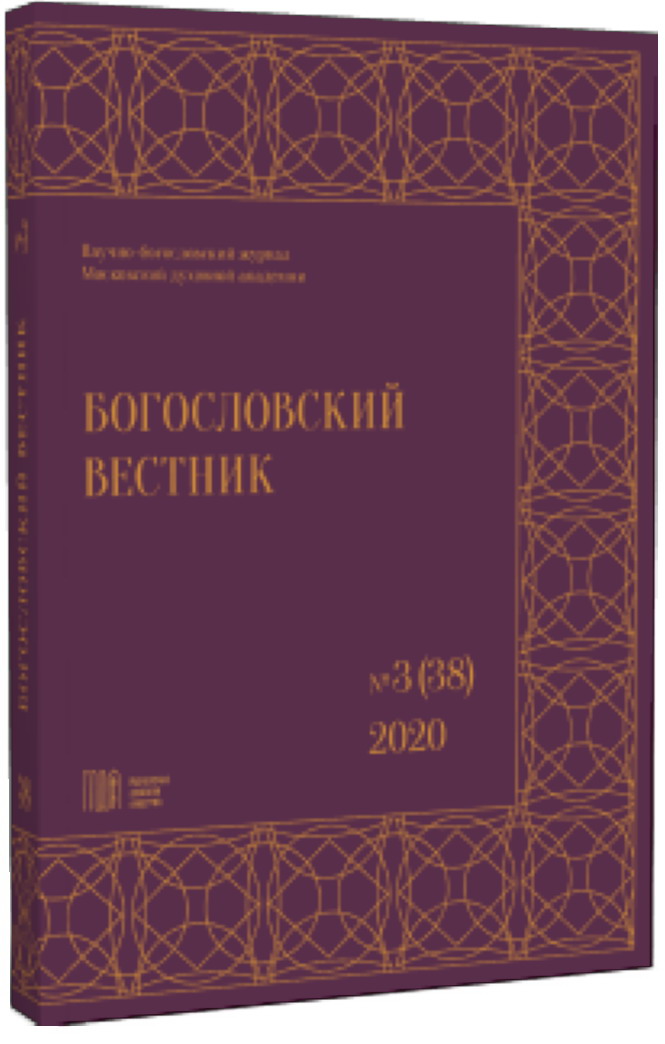The Theological Thought on the Holy Places in the Writings of Palestinian Hagiographers of the 6th — 7th Centuries: Themes, Origins, Tradition
DOI:
https://doi.org/10.31802/GB.2020.38.3.014Keywords:
hagiogrphy, the holy places of Palestine, theology of the holy places, pilgrimage, Theodore of Petra’s Life of St. Theodosius, Cyril of Scythopolis’ Lives, John Moschus’s Spiritual MeadowAbstract
The second part of this article continues the exploration of theological reflection on the holy places of Palestine in the works of these eminent hagiographers of Palestinian monasticism of the 6th-7th centuries: the Life of St. Theodosius by Theodore of Petra, a series of Lives compiled by Cyril of Scythopolis, and the Spiritual Meadow by John Moschus. In the light of patristic tradition a diverse range of moral, ascetical and exegetical topics of this theological field is examined, including: 1) the holy places as the living environment of Palestinian ascetics; 2) the veneration of the holy places, the flight from the world, and the desire for hesychia as a threefold factor of attraction to Palestine for ascetics; 3) Abraham (Gen. 12, 1) as a biblical typos of monastic retreat to the Holy Land and of the spiritual xeniteia in the light of tropological and literal exegesis; 4) God’s love as a moral and mystical basis for living near the Holy City; 5) the importance of prayer at the holy places, participation in sacraments and rituals, and fasting as a preparation for encounter with the holy places; 6) moral and ascetic restrictions on living at the holy places. This analysis of moral-ascetical and exegetical topics within the theology of the holy places attested in hagiographical literature shows multiple traces of intertextuality, which enables us to state that this theological reflection is a manifestation of a coherent and living patristic tradition. The two parts of this article seek to show that the origins of this theology flow from liturgical and exegetical traditions, the practice of venerating the holy places, and the dogmatic, moral, and ascetic theology of Palestinian and other patristic authors of the Christian Mediterranean.
Downloads
References
ИСТОЧНИКИ
Ambrosius Mediolanensis. Epistulae // PG. T. 16. Col. 876–1286.
Basilius Caesariensis. Enarratio in prophetam Isaiam // San Basilio. Commento al. profeta Isaia / ed. P. Trevisan. 2 vol. Torino: Società editrice internazionale, 1939.
Cyrillus Scythopolitanus. Vita Abramii // Kyrillos von Skythopolis / hrsg. E. Schwartz. Leipzig: Hinrichs, 1939. (TU. Bd. 49.2). S. 243–247.
Cyrillus Scythopolitanus. Vita Cyriaci // Kyrillos von Skythopolis / hrsg. E. Schwartz. Leipzig: Hinrichs, 1939. (TU. Bd. 49.2). S. 222–235.
Cyrillus Scythopolitanus. Vita Euthymii // Kyrillos von Skythopolis / hrsg. E. Schwartz. Leipzig: Hinrichs, 1939. (TU. Bd. 49.2). S. 3–85.
Cyrillus Scythopolitanus. Vita Joannis Hesychastae // Kyrillos von Skythopolis / Hrsg. E. Schwartz. Leipzig: Hinrichs, 1939. (TU. Bd. 49.2). S. 201–222.
Cyrillus Scythopolitanus. Vita Sabae // Kyrillos von Skythopolis / Hrsg. E. Schwartz. Leipzig: Hinrichs, 1939. (TU. Bd. 49.2). S. 85–200.
Cyrillus Scythopolitanus. Vita Theodosii // Kyrillos von Skythopolis / Hrsg. E. Schwartz.
Leipzig: Hinrichs, 1939. (TU. Bd. 49.2). S. 235–241.
Eusebius. Historia ecclesiastica // Eusèbe de Césarée. Histoire ecclésiastique / trad. et notes de G. Bardy. 3 t. Paris: Les Éditions du Cerf, 1952–1958. (SC; vol. 31; 41; 55).
Festugière A.-J. Les moines d’Orient. Vols. 1–4. Paris: Les Éditions du Cerf, 1961–1965.
Gregorius Nyssenus. Epistulae // Gregorii Nisseni Opera / ed. G. Pasquali. Vol. 8 (2). Leiden, 1959.
Hieronymus. Epistulae // Saint Jérôme. Correspondance / ét. ed trad. J. Labourt. 8 t. Paris: Les Belles Lettres, 1949–1963.
Joannes Chrysostomus. In Genesim (homiliae 1–67) // PG. T. 53. Col. 21–385; PG. T. 54. Col. 385–580.
Joannes Climacus. Scala paradisi 3 // PG. T. 88. Col. 631–1161.
Joannes Moschus. Pratum spirituale // PG. T. 87 (3). Col. 2852–3112;
Mioni E. Il Pratum Spirituale di Giovanni Mosco: Gli episodi inediti del Cod. Marciano greco II, 21 // Orientalia christiana periodica. 1951. Vol. 17. P. 61–94.
Origenes. Commentarii in evangelium Joannis // Origène. Commentaire sur saint Jean / texte critique, avant-propos, trad. et notes par C. Blanc. 5 t. Paris: Les Éditions du Cerf, 1966– 1992. (SC; vol. 120; 157; 222; 290; 385).
Palladius. Historia Lausiaca // Palladio. La storia Lausiaca / testo critico e commento a cura di G. J. M. Bartelink. Verona: Fondazione Lorenzo Valla, 1974.
Theodoretus. Historia religiosa // Théodoret de Cyr. L’histoire des moines de Syrie / intr., texte critique, trad. et notes par P. Canivet, A. Leroy-Molinghen. 2 t. Paris: Les Éditions du Cerf, 1977–1979. (SC; vol. 234; 257).
Theodorus Petraeus. Vita Theodosii // Usener H. Der heilige Theodosios. Schriften des Theodoros und Kyrillos. Leipzig: Teubner, 1890. S. 3–113.
ΠαπαδόπουλοςΚεραμεύς Ἀ. Ἀνάλεκτα Ἱεροσολυμιτικῆς σταχυολογίας. T. 4. СПб: тип. В. Киршбаума, 1897.
Феодорит Кирский, блж. История боголюбцев с прибавлением «О божественной любви» / вступ. ст. и пер. А. И. Сидорова. М., 1996.
ЛИТЕРАТУРА
Álvarez Gutiérrez R. El concepto de xénitéia en la hagiografía monástica primitiva // Studia patristica. 2017. Vol. 91. P. 313–323.
Bitton-Ashkelony B. Encountering the Sacred: The Debate on Christian Pilgrimage in Late Antiquity. Berkeley; Los Angeles; London: University of California Press, 2005.
Bitton-Ashkelony B. Pilgrimage in Monastic Culture in Late Antiquity // The Armenians in Jerusalem and the Holy Land / ed. M. Stone, R. Ervine, N. Stone, Lovain; Paris; Sterling: Peeters, 2002. P. 1–17.
Booth Ph. Sophronius of Jerusalem and the End of Roman History // History and Identity in the Late Antique Near East / ed. Ph. Wood. Oxford; New York: Oxford University Press, 2013.
Guillaumont A. Le dépaysement comme forme d’ascèse dans le monachisme ancien // Annuaire de l’École pratique des hautes études (Ve section). 1968. Vol. 76. P. 33–34.
Neary D. Constantinople and the Desert City: Imperial Patronage of the Judaean Desert Monasteries, 451–565 // From Constantinople to the Frontier: The City and the Cities / ed. N. S. M. Matheou, Th. Kampianaki, L. M. Bondioli. Leiden, Boston: Brill, 2016. P. 142–158.
Perrone L. Il deserto e l’orizzonte della città: Le «Storie monastiche» di Cirillo di Scitopoli // Cirillo di Scitopoli. Storie monastiche del deserto di Gerusalemme / trad. R. Baldelli, L. Mortari. Padova: Abbazia di Praglia, 2012. P. 9–96.
Perrone L. La chiesa di Palestina e le controversie christologiche dal concilio di Efeso (431) al. secondo concilio di Costantinopoli (553). Brescia: Paideia Editrice, 1980.
Sheridan M. Monastic xeniteia // Sheridan M. From the Nile to the Rhone and Beyond: Studies in Early Monastic Literature and Scriptural Interpretation. Roma: EOS Verlag Pontificio Ateneo Sant’Anselmo, 2012. P. 467–478.
Wilken R. L. Loving the Jerusalem Below: The Monks of Palestine // Jerusalem: Its Sanctity and Centrality to Judaism, Christianity, and Islam / ed. L. I. Levine. New York: Continuum, 1999. P. 240–250.
Wilken R. L. The Land Called Holy: Palestine in Christian History and Thought. New Haven; London: Yale University Press, 1992.








